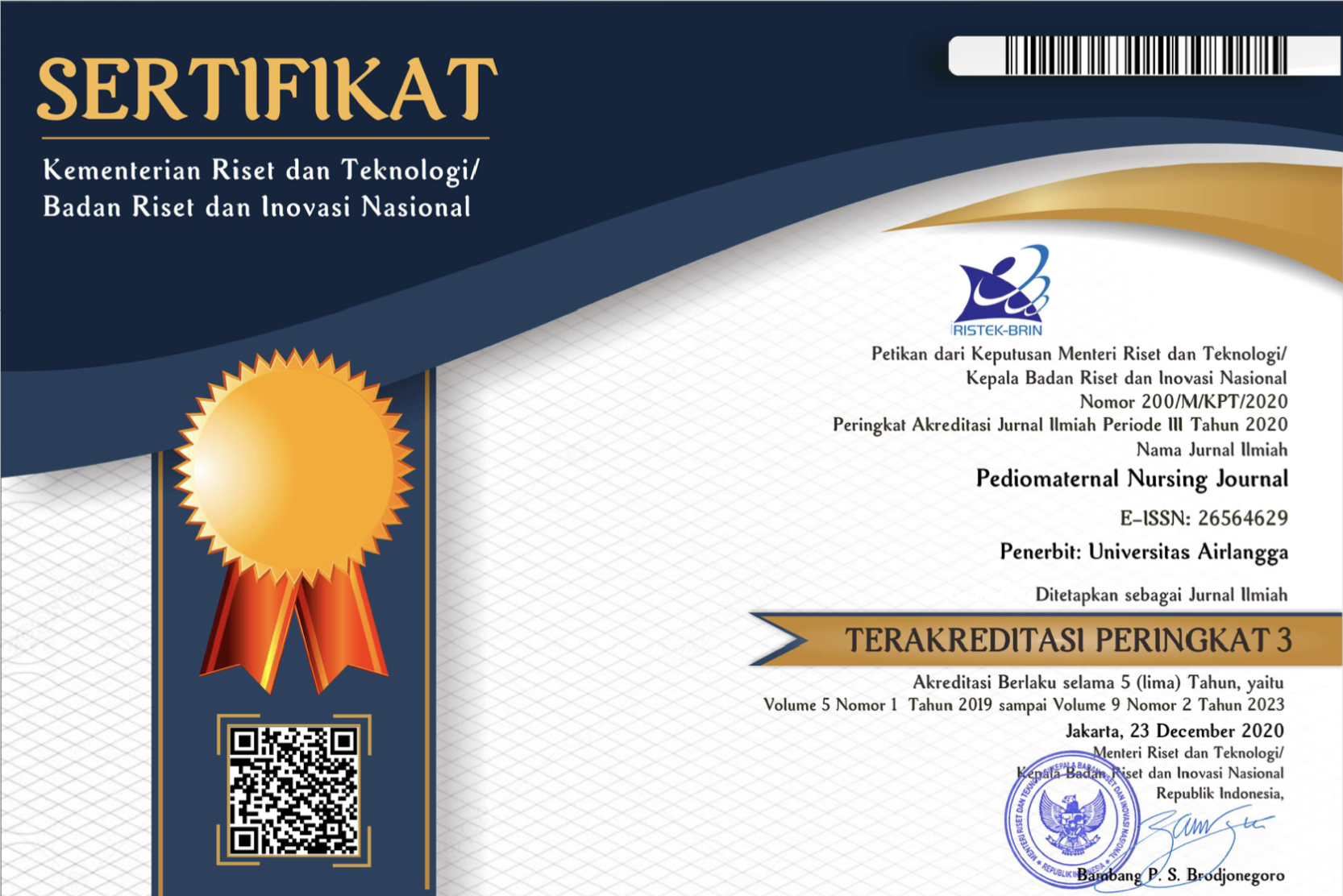Slime as Playing Therapy on Response of Biological, Psycological and Eating Behaviour of Preschool in Hospital
Downloads
Introduction: Slime is one of the toys that many kids like because it was adorable with a variety of bright and colorful color variations. The purpose of this study was to determine the effect of slime play therapy on biological, psychological, and eating behavior in preschool children who undergo hospitalization in the Dahlia Room of RSUD Mgr. Gabriel Manek, SVD Atambua.
Methods: This research used quasi experiment with post-test only non-equivalent control group design. The total population was 90 patients with a sample size of 60 respondents, divided into 30 treatment groups and 30 control groups. The sample was determined by consecutive sampling technique. The independent variable was slime play therapy. The dependent variable was biological, psychological, and eating behavior. Data were obtained by observation sheet and Child Eating Behavior Questionnaire (CEBQ) instrument and data were analyzed by the Mann-Whitney U Test.
Results: There were differences between the treatment group and the control group on respiratory frequency (p=0.021), pulse frequency (p=0.002), stress (p=0.035), and eating behavior (p=0.041).
Conclusion: Slime play therapy was an atraumatic care approach that can be used to reduce stress level hospitalization, biological responses to normal, and eating behavior to be good for children who were hospitalized.Terry K, Susan C. Buku Ajar keperawatan pediatri. Edisi 2. Jakarta: EGC; 2014. 134 p.
Tekin G, Sezer Ö. Applicability of play therapy in Turkish early childhood education system: today and future. Procedia - Soc Behav Sci [Internet]. 2010 Jan 1 [cited 2018 Apr 19];5:50–4. Available from: https://www.sciencedirect.com/science/article/pii/S1877042810014230
Tat F, Sing SA. Florentianus Tat*Selfiana A. Sing,. Pengaruh Ter Bermain Alat Kedokt Terhadap Perilaku Koop Dalam Asuhan keperawatan Anak Usia Pra Sekol Di Ruang Anak RSUD kefamenanu Kabupaten Timor Teng Utara . 2014;13:710–21.
Purnama AP. Efektivitas Penggunaan Media Video Dan Media Leaflet Terhadap Perubahan Pengetahuan Dan Sikap Siswa Tentang Bahaya Napza Di Smp Negeri 3 Mojosongo Boyolali. Universitas Muhammadiyah Surakarta; 2013.
Maharini T, Irawati, Susanti S, Salamah U, Retno S. Workshop: Pemanfaatan dan Pembuatan Alat Permainan Edukasi (APE) Pengembangan untuk Anak USia Dini dan Anak Berkebutuhan Khusus (ABK). Malang; 2017.
Marcus SM, Malas NM, Quigley JM, Rosenblum KL, Muzik M, LePlatte-Ogini DJ, et al. Partnerships with Primary Care for the Treatment of Preschoolers. Child Adolesc Psychiatr Clin N Am [Internet]. 2017 Jul 1 [cited 2018 Apr 19];26(3):597–609. Available from: https://www.sciencedirect.com/science/article/pii/S105649931730041X
Sherwood L. Human Physiology from Cells to System. 3rd ed. Cole: Brooks; 2012. 617-620 p.
Schwartz M, Woods S, Porte D. Central Nervous System Control of Food Intake. Nature. 2015;404:661–9.
Wang G, Lee H, Englande E. Ghrelin not just another stomach hormone. Regul Pept. 2002;105:392–428.
Diani N, Waluyo A, Sukmarini L. PENGETAHUAN KLIEN TENTANG DIABETES MELITUS TIPE 2 Pendahuluan Metode. J Keperawatan Indones. 2013;16(2):120–7.
Chronis-Tuscano A, Lewis-Morrarty E, Woods KE, O'Brien KA, Mazursky-Horowitz H, Thomas SR. Parent–Child Interaction Therapy With Emotion Coaching for Preschoolers With Attention-Deficit/Hyperactivity Disorder. Cogn Behav Pract [Internet]. 2016 Feb 1 [cited 2018 Apr 19];23(1):62–78. Available from: https://www.sciencedirect.com/science/article/pii/S1077722914001266
Dian A. Tumbuh Kembang dan Terapi Bermain pada Anak. 2nd ed. Raphita, editor. Jakarta: Salemba Medika; 2013.
Salluh JIF, Chiche JD, Reis CE, Soares M. New perspectives to improve critical care benchmarking. Ann Intensive Care [Internet]. 2018;8(1):18–20. Available from: https://doi.org/10.1186/s13613-018-0363-0
Sandra K. Manfaat Bermain Slime. In: Terapi Bermain. Jakarta: Alfabeta; 2014.
Vasilyeva EN, Shcherbakov A V. Parental Roles and Types of Parentings as Determinants of a Preschooler's Emotional and Personal Well-being. Procedia - Soc Behav Sci [Internet]. 2016 Oct 17 [cited 2018 Apr 19];233:144–9. Available from: https://www.sciencedirect.com/science/article/pii/S1877042816314057
Wulaningsih R. Hubungan antara Persepsi Pola Asuh Orangtua dan Kontrol Diri Remaja terhadap Perilaku Merokok di Pondok Pesantren. 2015;04(4):119–26.
Omaç Sönmez M, Nazik F, Erol L. Management of pain in children by paediatric nurses in Eastern Turkey. Kontakt [Internet]. 2018;20(3):e250–4. Available from: https://doi.org/10.1016/j.kontakt.2018.05.002
Kinasih RP. Nephrotic Syndrome in 2 Years Old Child. 2014;1.
Guyton AC, Hall JE. Buku Ajar Fisiologi Kedokteran. 12th ed. Singapore: Elsevier; 2014.
Sanditaria W. Adiksi Bermain Game Online Pada Anak Usia Sekolah Di Warung Internet Penyedia Game Online Jatinangor Sumedang. 2012;
Maree JE, Moshima D, Ngubeni M, Zondi L. On being a caregiver: The experiences of South African family caregivers caring for cancer patients. Eur J Cancer Care (Engl) [Internet]. 2018 Mar 1 [cited 2018 May 14];27(2):e12801. Available from: http://doi.wiley.com/10.1111/ecc.12801
Potter S. Employee Motivation, Psycology, Industri. New York: Mc. Graw Hill; 2009.
Masulili F, Hastono SP, Kesehatan P, Palu K, Utara P, Anak KK, et al. Metode Bimbingan Imajinasi Rekaman Audio untuk Menurunkan Stres Hospitalisasi pada Anak Usia Sekolah di Rumah Sakit di Kota Palu. 2013;17(36):61–9.
Llorca A, Cristina Richaud M, Malonda E. Parenting, Peer Relationships, Academic Self-efficacy, and Academic Achievement: Direct and Mediating Effects. Front Psychol [Internet]. 2017 Dec 15 [cited 2018 Mar 7];8(DEC). Available from: http://journal.frontiersin.org/article/10.3389/fpsyg.2017.02120/full
Copyright (c) 2019 Maria Yashinta Seran, Ilya Krisnana, Praba Diyan Racmawati

This work is licensed under a Creative Commons Attribution 4.0 International License.
1. The journal allows the author to hold the copyright of the article without restrictions.
2. The journal allows the author(s) to retain publishing rights without restrictions.
3. The legal formal aspect of journal publication accessibility refers to Creative Commons Attribution (CC BY).





















